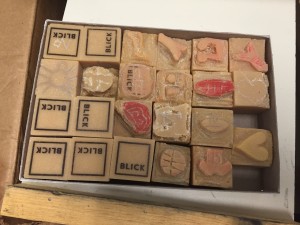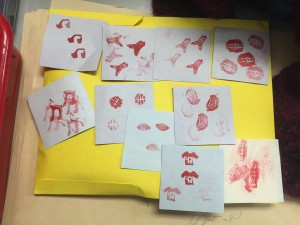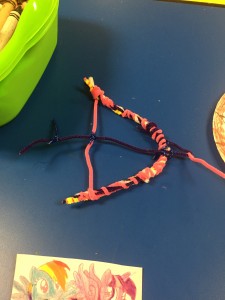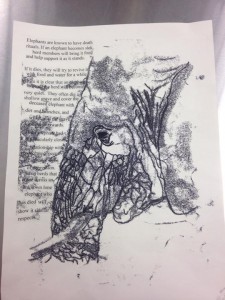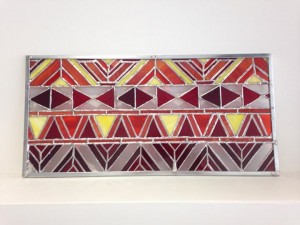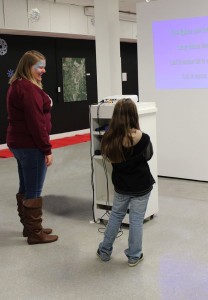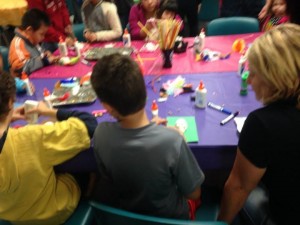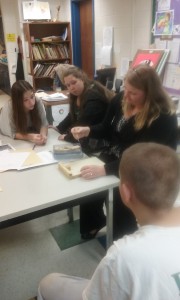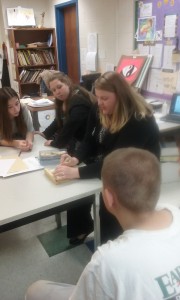Throughout my college career, it has come to my attention that the majority of education classes art educators are required to take that the professors are typically not familiar with the art classroom. Because of that, I am currently conducting my own research to gather resources that will assist art educators with classroom and behavioral management. Below are the resources I currently have found, and I am continuing to update it frequently.
Classroom and Behavioral Management in Art Bibliography
Abedin, G. (2010). Exploring the Potential of Art-Based Education for Adolescents with Learning Disabilities: A Case Study of Engagement in Learning through the Arts (Doctoral dissertation, University of Maryland, 2010). College Park, MD: Digital Repository at the University of Maryland.
Within this study, there is a case study that is all about art and students with learning disabilities. Within the study, there is an interview with a visual arts teacher, and she discusses different strategies and class procedures that work well to accommodate these students. The interviewee also goes into further detail about how she worked with students who had even more challenges than the students that are a part of the case study.
Anderson, K., Overy,K., (2010). Engaging Scottish Young Offenders In Education Through Music And Art. International Journal Of Community Music, 3(1) 47-64.
This study examines the effect that both music and art have on student engagement in education, self-esteem, self-control, and behavior and literacy skills. The results compare and contrast interviews that were conducted with each student before, during, and after the ten week study. There is also data proving that students had an increase in their self-esteems due to the study. Anderson and Overy, also write a section explaining why these changes in the students take place due to art and music.
Anderson, F. E. (2015). Art and the IEP. Retrieved April 30, 2016, from http://www.ldonline.org/article/5818/
This article discusses what an IEP, for a student taking art, should consist of. There is a template for an IEP and a sample IEP.
Armstrong, T. (2006). The Best Schools: How Human Development Research Should Inform Educational Practice. Alexandria, VA: Association of Supervision and Curriculum Development.
In Chapter 5, this book discusses the methods art educators can use to encourage their students to develop a sense of self. Discussed are also strategies to provoke self-advocacy and empathy from the students.
Baker, D. (2013). Art Integration and Cognitive Development. Journal For Learning Through The Arts, 9(1).
This journal entry explores how art education promotes cognitive development. It also touches on identifying how cognitive developments correlate with behavior. Baker discusses the importance of art education, and how it should be integrated into each classroom and school system. She also presents different research that backs up her own research of how art helps students improve in their core classes, as well.
Bickley-Green, C. (2007). Visual Arts Education: Teaching a Peaceful Response to Bullying. Art Education, 60(2), 6-12.
In this journal article, the art classroom is made to be the foundation of diminishing bullying. Examples are given throughout the article of how art educators can use their lessons to allow students to express themselves, instead of acting out behaviorally. There is also a chart that is to assist art educators in recognizing what category of behavior a student belongs to, and gives recommendations for how educators can respond to each type of behavior.
Broome, J. L. (2013). A Case Study in Classroom Management and School Involvement: Designing an Art Room for Effective Learning. Art Education, 66(3), 39-46.
This case study discusses the changes to an art room, and the impact it had on classroom management. An art teacher had the opportunity to collaborate with a school renovation committee in creating the new art classroom. She placed the focus on the new classroom on benefiting the classroom management aspect of it. Within the case study, it also discusses the importance of a teacher’s involvement within the school community, and how it can help classroom management.
Bush, M. A. (2007). Differentiated educational strategies in the elementary art classroom (Master’s thesis, Virginia Commonwealth University, 2007). Richmond: Virginia Commonwealth University.
This thesis has information that assists art educators in using the differentiation method within their classrooms. Bush explains how lessons can be differentiated through content, process, and product. She also discusses the different way art educators use group work within their classroom. There are also ten strategies of differentiation for art educators to possibly include in their instruction.
Davis, J. H. (2008). Why Our Schools Need the Arts. New York: Teachers College Press.
Within this book, educates readers on the different, important ways that art education has an impact on the way students develop, not just in their art skills but life skills. Discussed within is how art impacts students’ behavior and way of thinking. There are personal statements from students, teachers, and administrators throughout the book that elaborate on how the art class had an effect on their own and other’s behavior, development, and other academics.
Davis, J. H. (2012). Why Our High Schools Need the Arts. New York: Teachers College Press.
This book focuses on the important impact art has on high school students, and how educators can teach art to the full extent to have the biggest impact on their students. The chapters are broken down into different ways that art can change students’ behavior, understanding, and overall outlook of themselves. Discussed in this book are several personal developments students should achieve, and what art educators can do in their classrooms to get them there. A few of the personal developments discussed are agency, empathy, and responsibility.
Davis, K. (2007). Tips to Consider When Including a Student with ASD in Art, Music, or Physical Education. Retrieved April 24, 2016, from https://www.iidc.indiana.edu/pages/Tips-to-Consider-When-Including-a-Student-with-ASD-in-Art-Music-or-Physical-Education
This article focuses on tips and information on how art educators can include students with Autistic Spectrum Disorder. There are general steps and information given to help educators become better prepared to teach these students. Also, discussed is how to encourage other students in the classroom how to interact with students with autism. Then, there is a section in the article just for tips that art educators can use when teaching a student with ASD.
Derby, J. (2012). Enabling art education: Recent books that explore the intersection of disability and art education. Studies in Art Education, 53(3), 260-263.
This is an annotated bibliography that contains seven annotated scholarly sources that are beneficial to the study of art education and special education.
Douglas, K. M., & Jaquith, D. B. (2009). Engaging Learners Through Artmaking: Choice-Based Art Education in the Classroom. New York: Teachers College Press.
As the title of the book states, this book is structured around choice-based art classrooms. Also, discussed are different ways art educators can set up their classrooms in order to have the most effective and efficient classroom. Ideas for motivation, instruction, and assessment are also included.
Fine Arts for All Students: A Quick Reference for Students with Special Needs [PDF]. (2007). San Antonio: Center for Educator Development in Fine Arts.
This quick reference guide includes different modes art educators should give their students directions to accommodate every type of learner. It also discusses different categories of different strategies to maintain good behavior, and to regain good behavior within the classroom.
Furniss, G. J. (2007). Practical Considerations for Teaching Artists with Autism. Schoolarts: The Art Education Magazine For Teachers, 106(9), 6.
This article gives multiple suggestions to art educators on how to design lessons and unit plans while having a student who has autism in the classroom. Also, there are recommendations on how to assess these students accordingly.
Furniss, G. J. (2008). Designing Art Lessons for Children with Asperger Syndrome. Schoolarts: The Art Education Magazine For Teachers, 107(8), 20.
In this article, students with Asperger Syndrome are the main focus. Through appropriate teaching methods, which are discussed within, students with AS can improve many skills and talents. Steps on how to design art lessons for these students are also explained.
Graham, M. A., & Zwirn, S. G. (2010). How Being a Teaching Artist Can Influence K-12 Art Education. Studies in Art Education, (3). 219.
This research discusses the importance of art teachers continuing to make art work impacts their students. Within the research, Graham elaborates on why it is important for art teachers to still be active as artists, and the view students have of their teacher if they are doing so. He breaks down his research into different sections, such as, how artistic practice influenced interactions with students. The research gives a lot of information on how to build a better relationship with your students in the classroom through art.
Groves, J. E. (2006). Art as a Behavior Modification Tool. Multicultural Education, 13(4),55-57.
This article discusses how student’s behavior and academics improved through taking art class. Groves gives examples of what art disciplines helped improve different students with their behavioral issues.
Hassaan Chandio, J., Hussain, I., Ather Khan, H. M., & Gulrez, N. (2013). Arts Education as a Strategy for Eradicating Violent Behavior among University Students: A Novel Proposition. Pakistan Journal Of Commerce & Social Sciences, 7(3), 435-443.
In this article, Chandio reflects on research he found connecting art education and the decrease of violent behavior in some schools. There is date within that touches on how art education has a positive influence on student’s personal adjustment and self-concept. The main idea that is discussed within this article is how art education can provide a peaceful way for students to deal with conflicts, whether they are personal, political, or social, and help students become more understanding and appreciative or others who may not feel the same as they do.
Hetland, L., Winner, E., Veenema, S., & Sheridan, K. M. (2007). Studio Thinking: The Real Benefits of Visual Arts Education. New York: Teachers College Press.
This book focuses on how the studio work portion of art class. It educates readers on the importance of constructive critiques, and how those critiques play a role in students’ self-advocacy and their self-efficacy. An entire chapter of the book focuses on how art educators should encourage their students to have good relationships with their teachers and their classmates.
Hutzel, K., Bastos, F. M., & Cosier, K. (2012). Transforming City Schools Through Art: Approaches to Meaningful K-12 Learning. New York: Teachers College Press.
Throughout this book, art education is the base of meaningful urban education reform. There are sections that give examples of how art educators can have togetherness within their classroom, and even with the community. There is discussion of multiple ways art educators use art to reform students who have behavioral issues and needs. Throughout the book, there are personal narratives from art educators giving examples of how art can help improve student’s behavior.
IEPs and Beyond. (n.d.). Retrieved May 01, 2016, from https://www.teachervision.com/special-education/resource/17706.html
This webpage contains a number of links leading to sites dealing with things such as preparing IEPs, inclusion in the classroom, and assessment accommodations. There is also a section of this page that has links to other helpful related resources, as well.
Loesl, S. D. (2012). The Intersection of Arts Education and Special Education: Exemplary Programs and Approaches [PDF]. Washington, D.C.: The Kennedy Center.
This document contains personal experiences that art educators had with students with special needs. It also suggests different methods for modeling and co-teaching. Loesl gives tips for art educators who may have overfilled classes, and how to successfully follow student’s IEP’s.
Margrave, J. (2010, February 21). Students with Emotional/Behavioral Disabilities in the Art Room [DOC]. University of Central Florida.
In her research, Margrave discusses the difficulty involved in trying to find research on the connection between art education and behavioral management. She conducts some research herself, and includes the results within the document. Part of this research is how she used strategies that other content area educators use and adjusted them to allow them to work within the art classroom.
Mayer, A. (2012, November). Special Education and the Art Classroom: A Resource for Art Educators [PDF].
Within this document, Mayer offers a framework for art educators to create an inclusive art room. She also lists resources that can assist art teachers in better meeting the needs of their students with disabilities.
Mellan, G. (2014). Err; Failure in the Art Classroom (Doctoral dissertation, Corcoran College of Art Design, 2014). Washington D.C.: Corcoran College of Art Design.
This dissertation focuses on examining failure in the art classroom, or the unsuccessful classroom management of the art classroom. An important portion of this document is the section that talks about extrinsic and intrinsic motivation.
Ogle, A. (2013). Art Educational Practices: Fostering Self-Control and Improving Focus for Students Coping with Anxiety. Online Submission,
This scholarly research article gives multiple examples of how art education can be used to help students cope with things like depression and anxiety. The research goes even further to discuss how art education helps student’s express themselves in a creative way, rather than in a negative, behavioral way. Different methods of using creating lessons to help students cope with their struggles are discussed, as well. The research is all based off of observations made within the study that was conducted by Ogle.
Pearce, W. R. (2008). Special Learners Visual Arts. Retrieved April 25, 2016, from http://keyarts.wikispaces.com/Special learners visual arts.
Within this webpage is a substantial amount of information regarding art education and working with students with disabilities. On this webpage, you can click on a specific disability and it will take you to further information including strategies for working with students who have that specific disability and to a list of resources with even further information.
Rabkin, N. and Redmond, R. (2006). The Arts Make a Difference. Educational Leadership, 63(5).
This journal article focuses on integrated art classrooms. Within the article it also offers experiences from students and art educators of a low income school, and how they managed to maintain a productive and successful classroom without a great deal of art materials. Also, there are multiple sections of how an integrated classroom can be used to shape good behavior, and raise student achievement.
Ruppert, S. S., National Assembly of State Arts Agencies, W. D., & Arts Education, P. (2006). Critical Evidence: How the Arts Benefit Student Achievement. National Assembly Of State Arts Agencies,
This report elaborates on a few effects art classrooms have on students. Specifically, it gives examples of how certain aspects of art class have an effect on students at risk and students with learning disabilities. Another section of the report explains what some art educators have done in order to have a good relationship with their students, their colleagues, and the community, and to create a positive, safe environment.
Studies in Art Education Summer 2014. (2014). Retrieved May 2, 2016, from http://onlinedigeditions.com/publication/?i=217883
This web link leads to one of many of the volumes and issues of the National Art Education Associations journals. Within these journals there is updated research pertaining to art education. In this edition and issue, there is an article discussing concept-based inquiry in the high school art classroom. There is also an article about the connection between the art classroom with the community around it, and how it can be beneficial.
The College Board, Child Development and Arts Education: A Review of Recent Research and Best Practices, New York, N.Y., January 2012.
This research covers K-12 research on art education, and ways to have an effective classroom. Some main points discussed are the relationships art educators have with their students, the student choices art educators should provide, and how to create a safe learning community.
Wexler, A., & Cardinal, R. (2009). Art and Disability: The Social and Political Struggles Facing Education. New York: Palgrave Macmillan.
Each chapter of this book focuses on a different learning disability, and what art educators should focus on when it comes to students with that disability. In these chapters, Wexler briefly explains what each disability is for better understanding. The importance of having a relationship with each student is a continuous theme throughout this book, as well.
